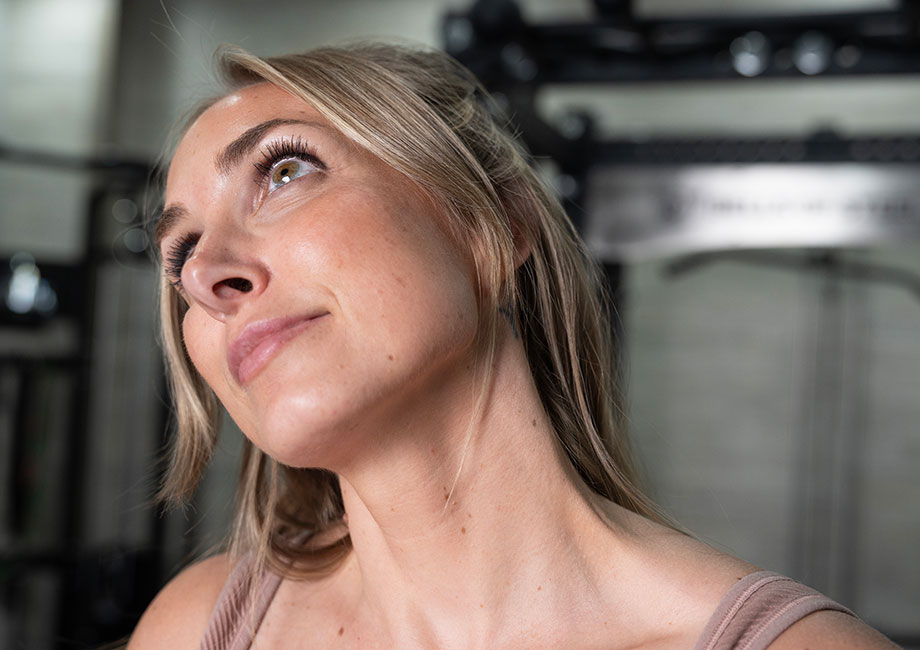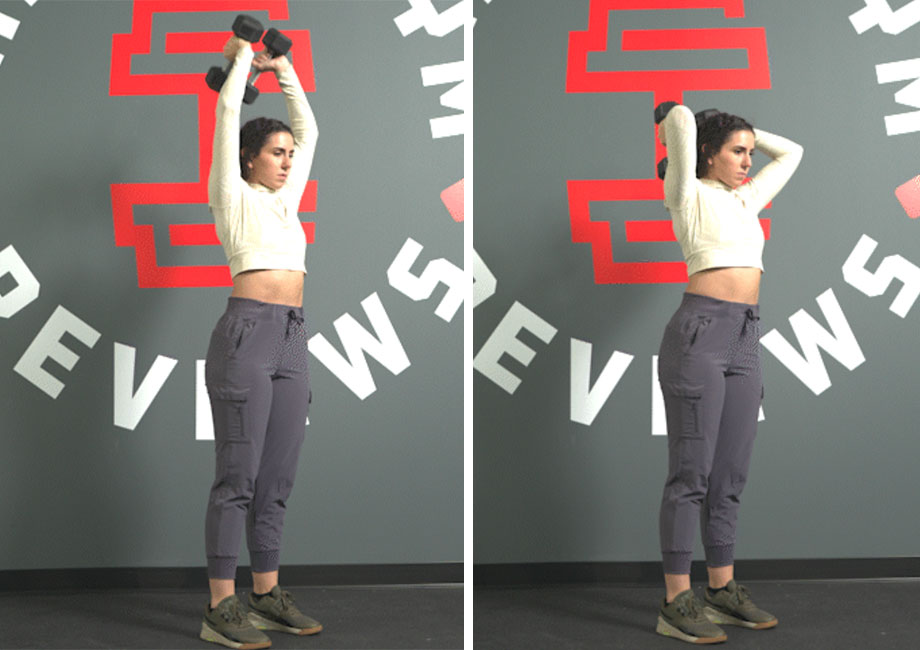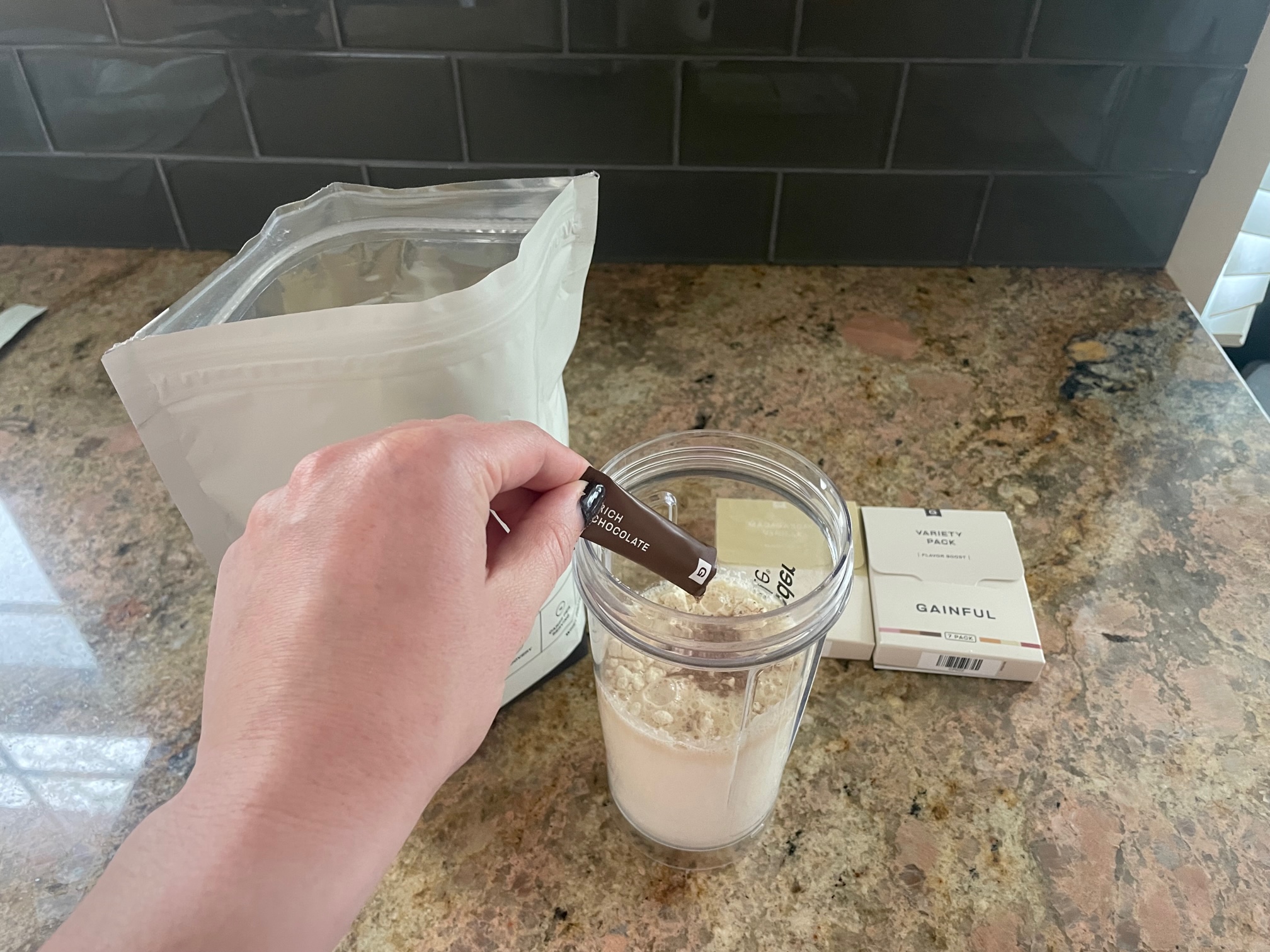Do you ever leave work with a stiff neck after sitting in front of a computer screen all day? Have you ever woken up after a good night’s sleep only to find your poor neck aching from that weird position you slept in?
You’re not alone.
According to the Mayo Clinic Proceedings1, neck pain is the fourth leading cause of disability worldwide, affecting more than 30% of the population annually. Thankfully, most neck pain resolves itself without medical intervention, but in some cases, the effects may significantly impact your quality of life.
We’ve asked Kate Meier, NASM-CPT, USAW-L1, CF-L1, and GGR senior director of content, to share five of the best neck exercises to help stretch and strengthen this critical yet often-overlooked muscle group so you can have what you need to keep your risk of injury low and get some much-needed pain relief. Check it out below!
RELATED: Office Workout
5 Best Neck Exercises
- Neck Circles
- Seated Neck Stretch (Side to Side)
- Chin Tuck
- Neck Rotation
- Scalene Stretch
Neck Circles
Muscles worked: Levator scapulae, scalenes, sternocleidomastoid, trapezius
Benefits: “Neck circles are a simple but effective exercise for stretching the neck,” says Kate Meier, NASM-CPT, USAW-L1, CF-L1. “The movement alternates between flexing and extending the neck to reduce neck pain and improve mobility.”
How to do it:
- Stand or sit down with your neck in a neutral position, a straight back, a tight core, and your shoulder blades pulled down and back while in the starting position.
- Gently tip your head to the right, bringing your ear toward your right shoulder.
- Slowly roll your neck in a circle, tucking your chin to your chest, moving to the left shoulder, pointing your chin to the ceiling, and finishing back at your right shoulder.
- Complete a few repetitions, then switch directions and repeat.
RELATED: 11 At-Work Stretches
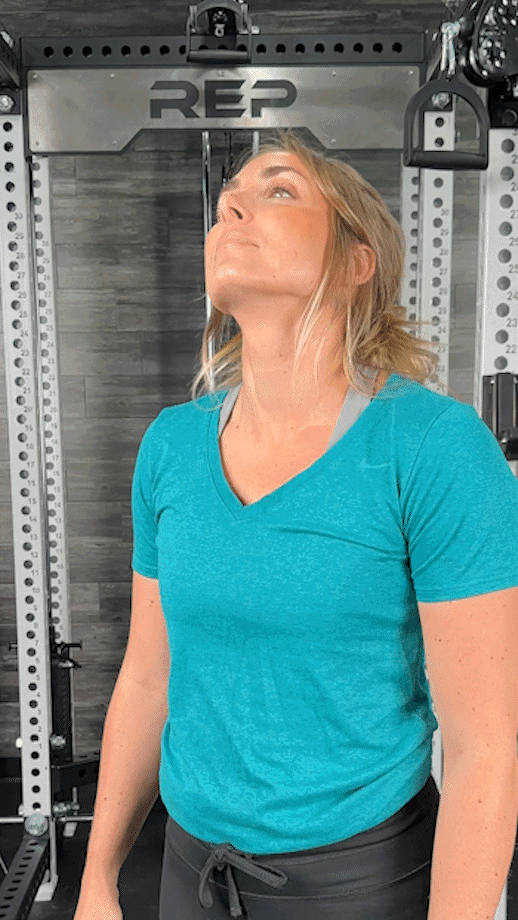
Seated Neck Stretch (Side-to-Side)
Muscles worked: Levator scapulae, scalenes, sternocleidomastoid, trapezius
Benefits: The seated neck stretch uses side-to-side movement to lengthen the neck muscles and alleviate tightness, but that’s not all. According to Physical Therapy in Sport2, it’s also one of the best exercises because “stretching the [levator scapulae] in the sitting position [may be] the most effective exercise for improving [levator scapulae] muscle length and cervical ROM.”
How to do it:
- From a seated position, take your left hand and grasp the bottom of your chair.
- Place your right hand on the left side of your head.
- Gently pull your head toward your left shoulder until you feel a stretch.
- Hold the position, take a few deep breaths, and relax.
- Release, then repeat the stretch on the opposite side.
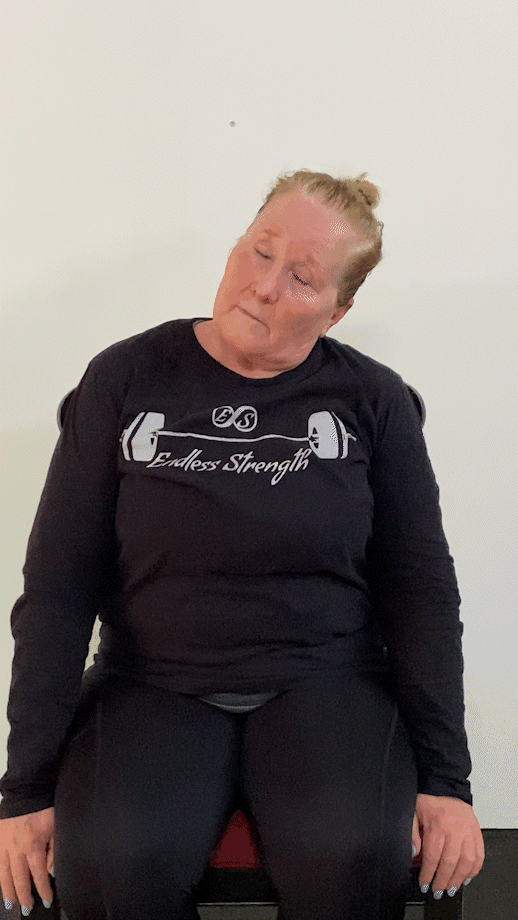
Chin Tuck
Muscles worked: Sternocleidomastoid, trapezius, scalenes, levator scapulae
Benefits: Chin tucks strengthen and stretch the muscles that promote good posture while increasing your overall neck mobility and flexibility. According to the Journal of Sport Rehabilitation3, they’re also one of the best corrective exercises for addressing forward head posture.
How to do it:
- Stand up straight with your back straight, neck neutral, and shoulders relaxed.
- Use one hand to gently push your chin down and back as though you’re giving yourself a double chin. Do not tilt your head or bend your neck during this step.
- Stretch your spine upward and hold the position.
- Relax.
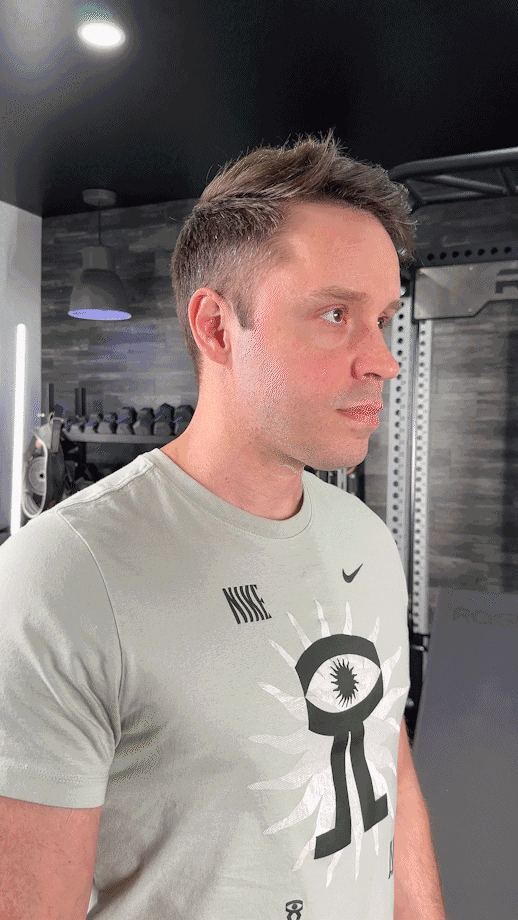
Neck Rotation
Muscles worked: Levator scapulae, scalenes, sternocleidomastoid, trapezius
Benefits: “Neck rotations are a gentle stretch used to lengthen the neck muscles to increase mobility, flexibility, and stability,” says Kate. “They’re also highly functional since it’s a movement we use frequently in our daily lives.”
How to do it:
- Stand up straight with your back straight, neck neutral, and shoulders relaxed.
- Slowly turn your head to look over your shoulder. Keep your chin level as you move.
- Continue until you feel a stretch. Stop immediately if you feel any pain.
- Hold the position for a few seconds, then relax.
- Repeat for the other side.
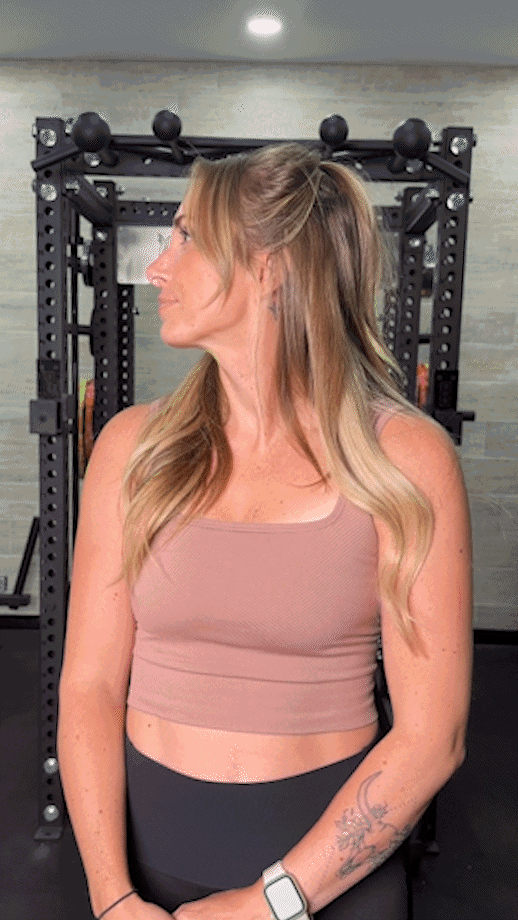
Scalene Stretch
Muscles worked: Scalenes, sternocleidomastoid, levator scapulae, trapezius
Benefits: The scalenes become gradually shortened over time due to poor posture, but the scalene stretch helps lengthen and strengthen them. This relieves tension and tightness in your neck and may help alleviate neck pain, too.
How to do it:
- Stand or sit with your back straight, neck neutral, and shoulders relaxed.
- Slowly tilt your head toward your right shoulder, stopping once you feel a stretch.
- Gently rotate your head to the left.
- Slightly tilt your chin up until you feel a pull in the front left side of your neck.
- Briefly hold the position, then relax.
- Repeat on your other side.
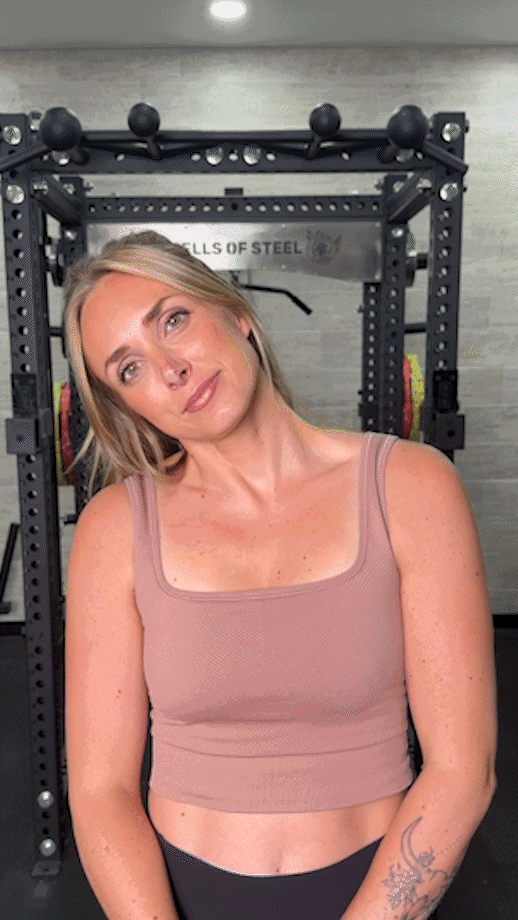
Sample Neck Exercise Workout
Our neck exercise workout helps lengthen and stretch your neck muscles after long periods of working or sitting down. It’s similarly effective as a warm-up before working out or if your exercise program includes pulling exercises or overhead movements.
“Make sure you move through these neck exercises slowly and carefully, paying close attention to your body and what it’s telling you,” says Kate Meier, NASM-CPT, USAW-L1, CF-L1. “Performing these gentle stretching exercises carefully may help reduce neck pain and improve neck muscle function, but rushing will more likely contribute to or cause neck pain.”
RELATED: Best Warm-Up Exercises
| Exercise | Sets | Reps |
| Neck Circle | 1-3 | 15-30 sec. |
| Seated Neck Stretch | 1-3 | 15-30 sec. |
| Chin Tuck | 1-3 | 15-30 sec. |
| Neck Rotation | 1-3 | 15-30 sec. |
| Scalene Stretch | 1-3 | 15-30 sec. |
What Muscles Make Up Your Neck?
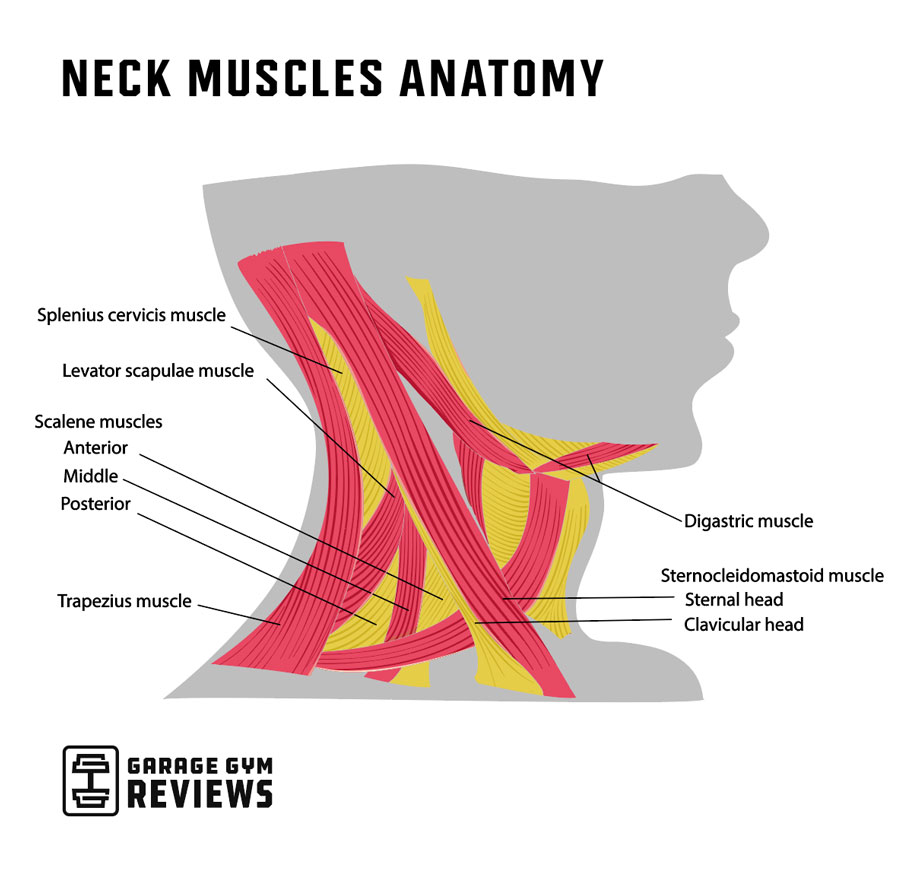
Your neck muscles are the unsung heroes of your upper body, working nonstop to move and stabilize that big ol’ melon sitting on top of them. The anatomy of your neck4 is complex, but the main neck muscles include:
- Levator Scapulae: The levator scapulae muscles stretch down the sides of your neck and attach to the shoulder blades. They assist in lifting the scapulae and control lateral neck movement and neck rotation.
- Sternocleidomastoid: These neck muscles attach at the sternum and collarbone in the front of your body. They help rotate your neck and tilt your chin upward.
- Scalenes: The scalenes are further subdivided into the anterior, middle, and posterior scalenes. They assist in respiration and contribute to neck flexion.
- Trapezius: The trapezius is technically an upper-back muscle, but it spans across the entirety of your cervical spine, attaching at the back of your head to stretch across your shoulders and down to your mid back. It contributes to head, neck, and shoulder movement.
RELATED: Trap Exercises
Benefits of Training Your Neck
Our neck exercises feel divine if you’re suffering from chronic neck pain or tightness, but what benefits should you expect to get from training your neck on the reg?
May Help Reduce Neck Pain
Neck pain is the fourth leading cause of global disability and, according to Occupational and Environmental Medicine5, sitting down at work is a common culprit. As more of the workforce becomes sedentary, it can feel like we’ll never get relief from this growing epidemic.
Well, actually, we can.
According to Clinical Rehabilitation6, “a regular stretching exercise program…can decrease neck and shoulder pain and improve neck function and quality of life for office workers who have chronic moderate-to-severe neck or shoulder pain.”
May Help Improve Neck Function
“Poor posture and inactivity leads to the gradual shortening of our neck muscles, which, in turn, creates tension, stiffness, and tightness,” says Kate. “Working neck exercises into your regular workout routine helps improve blood flow to these muscles, lengthen them, and enhance their range of motion and overall functionality.”
RELATED: Best Mobility Exercises
May Help Improve Posture
A study in Physical Therapy7 explored the relationship between poor sitting posture and neck pain, positing that strengthening your neck muscles may improve posture when using a specialized exercise program.
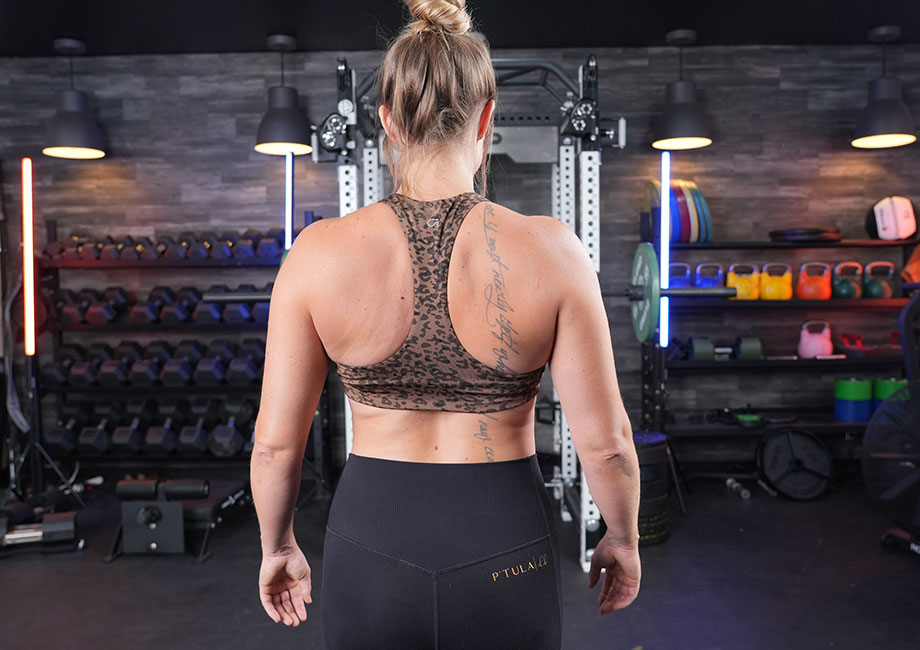
After a six-week program of neck exercises, “subjects with neck pain demonstrated an improved ability to maintain a neutral cervical posture during prolonged sitting,” meaning their posture improved from the intervention.
So, if you’re experiencing chronic lower back pain and neck pain from poor posture, working neck exercises into your fitness regimen may be just what you need.
Neck Exercises: Final Thoughts
Most gym-goers don’t need a reminder to pencil in splits like chest and triceps, back and biceps, or the dreaded but oh-so-important leg day. On the other hand, programming neck exercises is something that most fitness enthusiasts conveniently forget.
Your neck gets the never-ending job of moving and supporting your head, so it’s prudent to take a few minutes at the beginning or end of each workout to give those muscles a little bit of TLC. It may seem unusual at first, but trust us, the benefits make it well worth your while.
Neck Exercises: FAQs
How do you build muscle in your neck?
If you want to build muscle in your neck, neck exercises and stretches can help, but you’ll also want to target the larger muscle groups surrounding your neck, like your upper back and shoulders. That means movements like the barbell shrug, dumbbell shrug, and weighted neck extension.
What exercises tone the neck?
“The sternocleidomastoid is one of the most important muscles to target when working to tone your neck,” says Kate Meier, NASM-CPT, USAW-L1, CF-L1, and GGR senior director of content. “Chin tucks and neck rotations should help, but remember—exercise isn’t the only factor when it comes to that toned neck appearance. Eating right, getting enough rest, and a good skincare routine all contribute, too.”
How do older people strengthen their neck?
Incorporating our neck strengthening exercises may help stave off the ill effects of aging, like muscular atrophy. However, the best way for older individuals to retain neck strength and muscle is by working with a healthcare provider, physical therapist, or other qualified healthcare professional.
References
- Cohen SP. Epidemiology, diagnosis, and treatment of neck pain. Mayo Clin Proc. 2015;90(2):284-299. doi:10.1016/j.mayocp.2014.09.008
- Jeong HJ, Cynn HS, Yi CH, et al. Stretching position can affect levator scapular muscle activity, length, and cervical range of motion in people with a shortened levator scapulae. Phys Ther Sport. 2017;26:13-19. doi:10.1016/j.ptsp.2017.04.001
- Titcomb DA, Melton BF, Miyashita T, Bland HW. Evidence-Based Corrective Exercise Intervention for Forward Head Posture in Adolescents and Young Adults Without Musculoskeletal Pathology: A Critically Appraised Topic. J Sport Rehabil. 2022;31(5):640-644. Published 2022 Feb 16. doi:10.1123/jsr.2021-0381
- Roesch ZK, Tadi P. Anatomy, Head and Neck, Neck. [Updated 2023 Jul 24]. In: StatPearls [Internet]. Treasure Island (FL): StatPearls Publishing; 2024 Jan
- 5. Ariëns GA, Bongers PM, Douwes M, et al. Are neck flexion, neck rotation, and sitting at work risk factors for neck pain? Results of a prospective cohort study. Occup Environ Med. 2001;58(3):200-207. doi:10.1136/oem.58.3.200
- Tunwattanapong P, Kongkasuwan R, Kuptniratsaikul V. The effectiveness of a neck and shoulder stretching exercise program among office workers with neck pain: a randomized controlled trial. Clin Rehabil. 2016;30(1):64-72. doi:10.1177/0269215515575747
- Falla D, Jull G, Russell T, Vicenzino B, Hodges P. Effect of neck exercise on sitting posture in patients with chronic neck pain. Phys Ther. 2007;87(4):408-417. doi:10.2522/ptj.20060009


